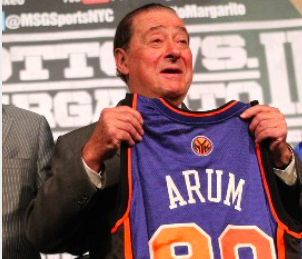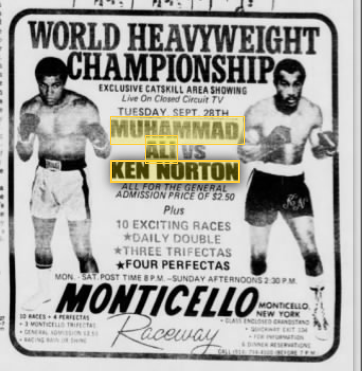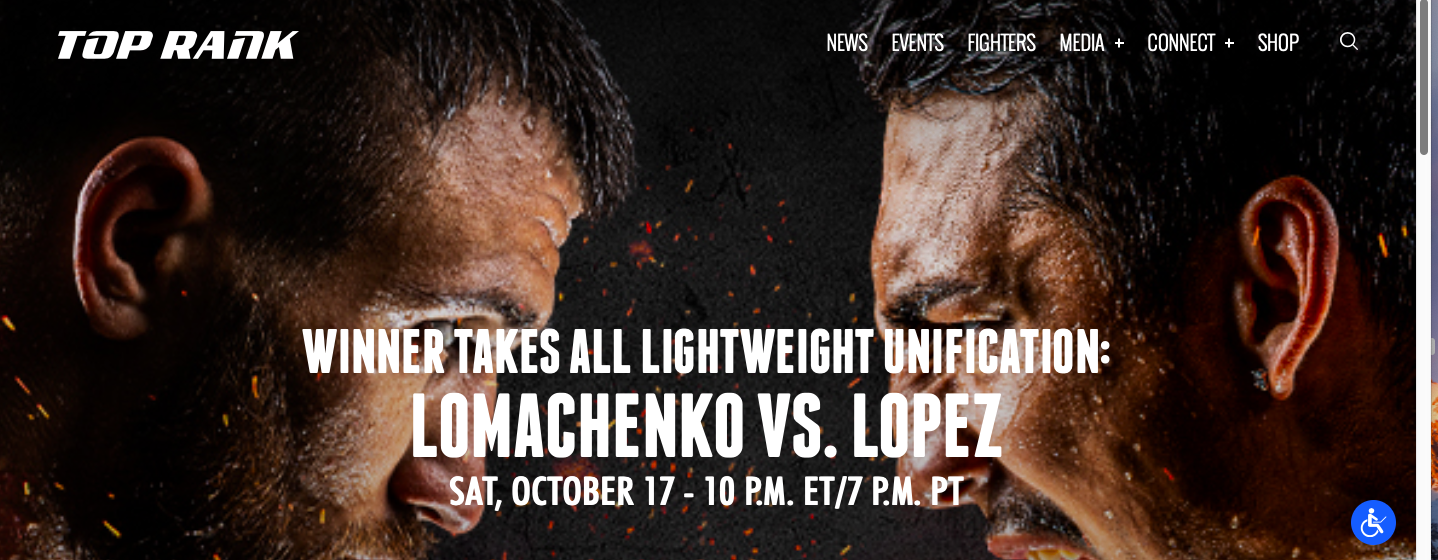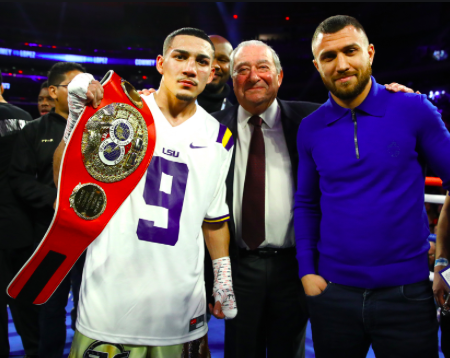Bob Arum says the market has spoken, signaling time to move good fights off PPV

On surface, there doesn’t seem to be that much of an obvious connection between what happened at Yankee Stadium on Sept. 28, 1976, and what will occur at the MGM Bubble on Oct. 17, 2020.
Yes, boxing held center stage then and will on Oct. 17.
And the same man is steering the promotional vessel bringing the anticipated main events to fight fans. Bob Arum put together the third Muhammad Ali-Ken Norton fight, and he also crafted the Vasiliy Lomachenko (14-1 with 10 KOs; age 32) versus Teofimo Lopez (15-0 with 12 KOs; age 23) lightweight showdown which will run on ESPN. OK, that in itself is a minor miracle, being that Arum turns 89 in December, and he still has the fastball to brushback rivals edging toward his turf. But what’s the link beyond those correlatives? Arum explained the connection on a Wednesday phoner, why he draws a line from the bicentennial night Ali scored a UD15 and broke the 1-1 tie between him and Norton in da Bronx, and the lightweight shootout between the veteran marksman from Ukraine and the young gunner born in Brooklyn.
It’s because of how the marketplace reacted to the final faceoff in the Ali-Norton trilogy, the lesson he drew from a piece of that market speaking, and what he believes the market is now telling boxing bigwigs, event planners and platforms.
“I’ve been around a long time,” said the man who jumped into the shark pool with the 1966 Ali vs. George Chuvalo fight. “And in September 1976, we had Ali against Norton, and the closed circuit did nothing. And that had nothing to do with the police.”
The reference to the cops has to do with the fact that towards the end of summer into fall 1976, NYPD were in a beef with city officials. To prove a point, a contingent of off duty cops gathered outside the stadium, and barked and held signs signaling their stance the night of the nine-bout card at the Stadium. They’d walked from Manhattan to the park to help call attention to their cause. A new contract for cops called for a wage freeze and also more hours spent working, so the boys in blue were irked.
Thus, it was every man, woman and fighter for themself at the home of the Yankees on that evening in late September. Or so it sometimes felt, because reporters wrote of marauding riffraff pin-balling around the park, causing a ruckus, while about 500 uniformed and 1,000 plus off duties let them discharge their energy. (If you want a deeper dive into that night, read this. I wrote it in 2010, for ESPN NY. I talked to Angelo Dundee, Ken Norton, Arum, Larry Merchant and Jerry Izenberg, whose quote won kicker status.)
If you had read up on the cop problems, you might have been scared off from going to the ballpark, figuring there could be a work slowdown, and maybe an unsafe environment. Perhaps then you considered instead watching a “closed circuit” showing; you could spend $2.50 and watch horse racing and also the fight at Monticello Raceway.

Or you could spend $30 to watch “The Greatest” against Kryptonite Ken at Madison Square Garden’s Felt Forum, or between $15 and $20 at locations across the nation. Or you could pass, which is what more folks than Arum figured would do, did.
“The closed circuit shit the bed really badly, but I got bailed out by CBS. They had the delay, and it was a controversial decision, so they paid extra money for the delayed showing. And the point is, from that September 1976 event, until June 1980, there wasn’t one event on closed circuit,” Arum told RING.
Ali’s next fight (May 16, 1977) came against Alfredo Evangelista (click here for “Best I Faced” picks from ‘Fredo), two notches down from Norton, and Don King promoted it, getting money from ABC, which screened the clash in prime time.
Next, Ali went on network TV again, to fight Earnie Shavers on NBC (Sept. 29, 1977), no closed circuit. Same with the next Ali fight, when on February 15, 1978 he met 6-0-1 Leon Spinks and lost via split decision in Vegas, with CBS this time buying the time of the 36 year old Ali. ”
“Big stadium fights are dead. So are closed circuit events,” said Arum, as reported by the Associated Press on Feb. 21…get ready for it…1978. “Once you give away the fight for free on commercial television the fan is spoiled. He will never pay again.”
Arum recalls that Sugar Ray Leonard advisor Mike Trainer in 1980 suggested they go that closed circuit route, and the timing was right. He remembers that being a big-ticket return for CCTV, though that transmission/distribution mode did get employed selectively before Leonard-Duran I. Don King looked to get another revenue stream going, via CC, when he matched Larry Holmes against Mike Weaver on June 22, 1979, and added Roberto Duran v Carlos Palomino to the card. Madison Square Garden, which at the time had a boxing department and had a budget to bring bouts to the building, didn’t want to buy the fights. So DK rented the building (for $150,000), sold tix for that, and also set up closed circuit showing around the US. Oh, almost forgot, he also sold the stream to HBO, available in 2 million homes, for $200,000.
And today’s grand scheme of things, with so many platforms littering the landscape, an ESPN, which is the platform for the Lomachenko-Lopez clash, is just about akin to “commercial television.”

I was curious what Arum thought about this period in boxing, the wellness of the sport, as an attraction. And in that vein, is he attaching extra importance to how well the Lomachenko-Lopez fight does, ratings-wise, on ESPN? “It’s very, very important for boxing, this fight is humongous,” he stated.
The Las Vegas-based marketer/packager said he heard the Showtime pay per view featuring a Jermell Charlo-Jeison Rosario junior middle bout and a Jermall Charlo middleweight title defense against Sergiy Derevyanchenko didn’t do so hot. Maybe 50,000 buys, he said he heard.
Another fightgame lifer without a direct dog in the hunt said that the Charlos, he heard, snagged about 70,000 buys on Sept. 26. “Maybe it’s 60, in between, my numbers are 50,000, but anyway, it’s on the margins,” Arum said. He said he heard about one of the principals making $3 million and so he had to wonder if that’s true, then what the Charlos made. “Who the fuck takes that kind of loss,” he said, while speculating about the numerary particulars of the presentation.
(SIDE NOTE: Speculation is the word, here. If and when Showtime wants to discuss how many buys their event did, they are welcome to. I’ve written before and will reiterate, I’m a fan first, and nope, I don’t adore seeing the beefed up cable bill after I hit the buy button. But we are an outlaw sport, which doesn’t get corporate backing, so paying extra to keep the purse juices flowing is a price we pay.)
Arum is thinking that we are amidst a shift in the cycle. Closed circuit made inroads in the 50s into the 60s, and yep, Ali did well with it, because he was that sort of draw, had fans (and haters) in nooks all over the world. Then the networks started bidding against each other, and their CEOs got milked for a spell. Next, cable ascended, and HBO realized that they could corral a solid bit of space in the boxing market. So their checks had more zeros on them than the networks were paying, and also nets got spooked by ring deaths and how to proceed post Ali, so the cable train got ridden hard and far.
Pay per view, which allowed people to be lazy, and watch from the comfort and safety of their home, inflated purses more, for the top draws. And, it can be argued, that construct benefitted the fighters who succeeded in that arena, and some recipients of the trickle down. But it also birthed plenty of downsides. Putting the best bouts behind a pay wall meant that casuals didn’t get hooked on the product as often. It also meant that inflated purses took on greater importance to fighters, over the thrill of victory, and that ascending the earnings ladder often took precedence over mastery of craft. (By the way, that isn’t a hit to be absorbed by boxers only–that is critique that can be applied to many souls splashing in the late-stage capitalism pool.)
“We’re in that area now…it will be nothing but huge, huge events on pay per view, and everything else will be free on networks, on ESPN+, on DAZN, and people won’t have to go into their pockets as much,” Arum continued. “This is the time to move, move as many big fights as we can from pay per view to free TV. That’s why Lomachenko vs. Lopez (on ESPN) is so important.”

Bob Arum is setting a bar for Lomachenko vs. Lopez. He says yes, boxing can really use this lightweight clash to kick ass, and draw heavy eyeballs.
A big and juicy ratings number now can’t be compared to back in the day, though. We won’t again revisit the hold enjoyed by the big three networks before cable started diluting their power of attraction, with 50 channels, then 100, then 500, etc.
“When we moved from closed circuit, then we did the Ali-Spinks rematch, and it broke records,” the promoter said. ABC paid too handsomely, but liked being able to say that at any given time during the main event, the fight was seen in 34.8 million homes. The net said at the time that 90 million people watched the bout, making it the most watched sporting event ever, at that time. “Down the road, a Super Bowl passed it,” Arum shared.
Those were the days. These are not those days.
“You can’t take a good fight and have it on pay per view. The Charlo fights, those were good fighs. But just because it’s good, it doesn’t mean it’s pay per view,” Arum told me. “That’s over. If you get a Anthony Joshua versus Tyson Fury, or Fury versus Wilder again, you probably still do pay per view. Listen, I’m not shitting on anybody…But Errol Spence against Danny Garcia, it’s a decent fight. It would do extremely well on Fox, but it’s not gonna do crap on pay per view, not because of a lack of quality, but because people are not gonna spend that money. They’re not gonna pay that money. They are not spending $75 or $80, that’s a lot of money (in this economic environment). People going forward are not going to be compelled to spend that money.”
UFC, we discussed, they do have a base of people who are still willing more so to pony up. “It’s a real small base but they are still willing to go into their pocket. Give it a year, two years, you’ll get that again, they won’t pay for it, for regular events. Market wise, that’s how people react. They say, ‘Hey, that’s enough. I ain’t spending for this product.’ At a certain point, they won’t spend for the product.”
I admitted to Arum, I’ve felt at times like maybe boxing lost ground during the pandemic period. I hear no shortage of people telling me they’ve been edging toward MMA more, that boxing isn’t giving us the marquee matches, or at least enough coin-flip fights involving at least B+ and B fighters. If we have lost ground, maybe it’s partially because the NBA, and MLB and NFL has that structure, that forces matchups to be made?
“I don’t think so, I don’t think we have (lost ground),” Arum countered. He said that when Top Rank ran Bubble shows in the summer, ok, the numbers didn’t pop. “With the ratings, numbers can look like anemic, but every fight we did it was the number one rated show on ESPN that day,” he explained. That’s why networks show re-runs, still, in the summer, he said, because people are out and about and viewership is down.
So, is he saying there is grounds for optimism, that this fall and we winter we can get a good run?
“If we present the best product, on free TV, like Lomachenko against Lopez, we’ll get the fans,” the ex lawyer turned hype man said. “That will help restore things.”
–Reach out to Michael Woods on LinkedIn, if you like















